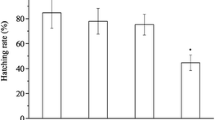Abstract
Contamination by heavy metals and sex hormones in a water environment is an important health issue. In this study, we investigated the estrogenic effects of cadmium (Cd) administration alone and in combination with 17beta-estradiol (E2) on the hepatocytes of male Bullfrog (Rana catesbeiana). Their vitellogenin (VTG) expression and reactive oxygen species (ROS) were analyzed upon exposure to Cd alone or to both Cd and E2. Our results suggest that the VTG levels induced by the co-treatment of 100 nM E2 and 100 nM CdCl2 were significantly higher than those induced by 100 nM E2 alone (p < 0.05), and were comparable to vitellogenin induction observed with 1 μM E2. A similar result was observed by western blot analysis in the culture medium of hepatocytes. Meanwhile, Cd (but not E2) increased the ROS levels. These results suggest that Cd has a cooperative effect with E2 in the induction of VTG, thus acting as an estrogenic disruptor. Cd also causes oxidative stress that occurs with the enhanced vitellogenesis.



Similar content being viewed by others
References
Ait-Aissa S, Ausseil O, Palluel O, Vindimian E, Garnier-Laplace J, Porcher JM (2003) Biomarker responses in juvenile rainbow trout (Oncorhynchus mykiss) after single and combined exposure to low doses of cadmium, zinc, PCB77 and 17 beta-oestradiol. Biomarkers 8:491–508
Canapa A, Barucca M, Gorbi S, Benedetti M, Zucchi S, Biscotti MA, Olmo E, Nigro M, Regoli F (2007) Vitellogenin gene expression in males of the Antarctic fish Trematomus bernacchii from Terra Nova Bay (Ross Sea): a role for environmental cadmium? Chemosphere 66:1270–1277
Carmichael J, DeGraff WG, Gazdar AF, Minna JD, Mitchell JB (1987) Evaluation of a tetrazolium-based semiautomated colorimetric assay: assessment of radiosensitivity. Cancer Res 47:943–946
Colborn T (2002) Clues from wildlife to create an assay for thyroid system disruption. Environ Health Perspect 110:363–367
Guevel RL, Petit FG, Goff PL, Metivier R, Valotaire Y, Pakdel F (2000) Inhibition of rainbow trout (Oncorhynchus mykiss) estrogen receptor activity by cadmium. Biol Reprod 63:259–266
Hsiao CJ, Stapleton SR (2004) Characterization of Cd-induced molecular events prior to cellular damage in primary rat hepatocytes in culture: activation of the stress activated signal protein JNK and transcription factor AP-1. J Biochem Mol Toxicol 18:133–142
Iavicoli I, Fontana L, Bergamaschi A (2009) The effects of metals as endocrine disruptors. J Toxicol Environ Health B 12:206–223
Järup L, Åkesson A (2009) Current status of cadmium as an environmental health problem. Toxicol Appl Pharmacol 238:201–208
Kim BH, Takemura A, Kim SJ, Lee YD (2003) Vitellogenin synthesis via androgens in primary cultures of tilapia hepatocytes. Gen Comp Endocrinol 132:248–255
Kim HJ, Hwang NR, Lee KJ (2007) Heat shock responses for understanding diseases of protein denaturation. Mol Cells 23:123–131
Kloas W (2002) Amphibians as a model for the study of endocrine disruptors. Int Rev Cytol 216:1–57
Kloas W, Lutz I, Einspanier R (1999) Amphibians as a model to study endocrine disruptors: II. Estrogenic activity of environ chemicals in vitro and in vivo. Sci Total Environ 225:59–68
Li CR, Jung KS, Lee SH, Kim A, Park JS (2006) Development of a sandwich enzyme-linked immunosorbant assay for the quantification of vitellogenin in Bullfrog (Rana catesbeiana). Chemosphere 63:1485–1490
McLachlan JA (2001) Environmental signaling: what embryos and evolution teach us about endocrine disrupting chemicals. Endocr Rev 22:319–341
Mitsui N, Tooi O, Kawahara A (2003) Sandwich ELISAs for quantification of Xenopus laevis vitellogenin and albumin and their application to measurement of estradiol-17 beta effects on whole animals and primary-cultured hepatocytes. Comp Biochem Physiol C Toxicol Pharmacol 135:305–313
Queiroz EK, Waissmann W (2006) Occupational exposure and effects on the male reproductive system. Cad Saude Publica 22:485–493
Radice S, Ferraris M, Marabini L, Chiesara E (2002) Estrogenic activity of procymidone in primary cultured rainbow trout hepatocytes (Oncorhynchus mykiss). Toxic in Vitro 16:475–480
Radice S, Fumagalli R, Chiesara E, Ferraris M, Frigerio S, Marabini L (2004) Estrogenic activity of procymidone in rainbow trout (Oncorhynchus mykiss) hepatocytes: a possible mechanism of action. Chem Biol Interact 147:185–193
Risso-de Faverney C, Orsini N, de Sousa G, Rahmani R (2004) Cadmium-induced apoptosis through the mitochondrial pathway in rainbow trout hepatocytes: involvement of oxidative stress. Aquat Toxicol 69:247–258
Sole M, Porte C, Barcelo D (2001) Analysis of the estrogenic activity of sewage treatment works and receiving waters using vitellogenin induction in fish as a biomarker. Trac-Trend Analyt Chem 20:518–525
Sumpter JP, Jobling S (1995) Vitellogenesis as a biomarker for estrogenic contamination of the aquatic environment. Environ Health Perspect 103:173–178
Takiguchi M, Yoshihara S (2006) New aspects of cadmium as endocrine disruptor. Environ Sci 13:107–116
Wang H, Joseph JA (1999) Quantifying cellular oxidative stress by dichlorofluorescein assay using microplate reader. Free Radic Biol Med 27:612–616
Wyllie S, Liehr JG (1997) Release of iron from ferritin storage by redox cycling of stilbene and steroid estrogen metabolites: a mechanism of induction of free radical damage by estrogen. Arch Biochem Biophys 346:180–186
Acknowledgments
This work was supported by a Grant from the National Research Foundation of Korea (2010-0017025).
Author information
Authors and Affiliations
Corresponding author
Rights and permissions
About this article
Cite this article
Lee, K.W., Chang, Z., Oh, BS. et al. Estrogenic Response in Male Bullfrog (Rana catesbeiana) Hepatocytes After Single or Combined Exposure to Cadmium (Cd) and 17beta-Estradiol (E2). Bull Environ Contam Toxicol 85, 452–456 (2010). https://doi.org/10.1007/s00128-010-0119-5
Received:
Accepted:
Published:
Issue Date:
DOI: https://doi.org/10.1007/s00128-010-0119-5




